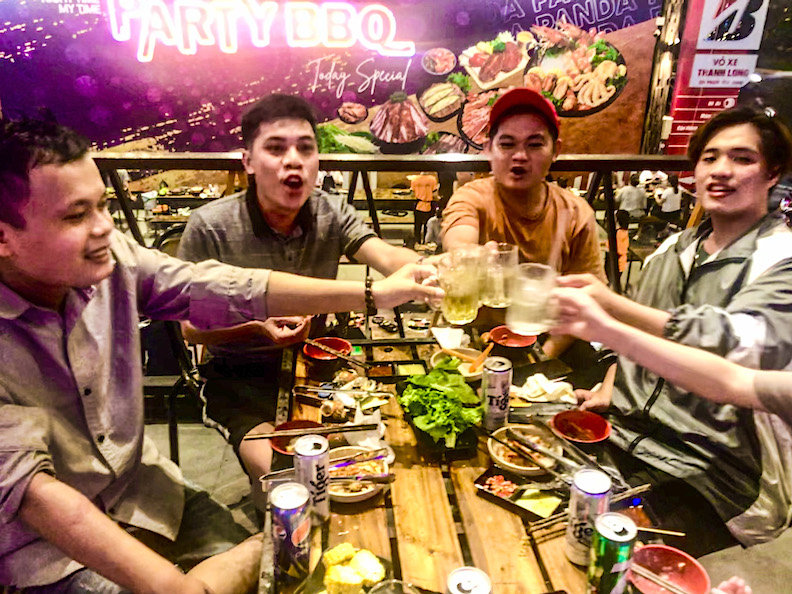
Môt, hai, ba, yo! Young friends toast a celebratory evening at an open-air barbecue restaurant in Ho Chi Minh City, where it seems every night is a party night. Vietnam is far and away the leading beer-drinking country in Southeast Asia. Photo by John Gottberg Anderson
At a kindergarten graduation ceremony last week in Saigon’s Binh Tán district, the drinking began before noon. Diplomas were distributed, photos snapped; then parents took their children home, leaving more than two dozen mostly young Vietnamese school teachers to enjoy a celebratory business lunch.
The meal started about 10:30 a.m., not particularly early for a lunch in this country. It was, however, early for alcohol. No matter. As soon as the tables were set, the Tiger Crystal beers were opened and poured over ice. At least 80 percent of the attendees were female, and they weren’t holding back. By noon, after a meal of soup, chicken, whole fish, beef, pork and dessert, no one was feeling any pain.
One young American teacher, only a few months in Vietnam, wondered if he was doing the right thing, drinking in the morning with his attractive co-workers … and his beguiling boss. “You don’t have a choice,” said an older associate. “She told you to drink. So, drink. Buộc tay. Your hands are tied.”
“Môt, hai, ba, yo!” (“One, two, three, cheers!”) shouted the women.
The Social Fabric
Throughout Vietnam, drinking beer is woven into the social fabric. At family affairs and business lunches, impromptu meetings and private karaoke parties, beer flows like water. Cartons of beer — Saigon Special and Bia Hanoi, 333 and Larue, 24 cans to a box — balance in towering store displays and on the backs of motorbikes that careen through swarming traffic en route to their final destinations.
A 2022 survey reported the average annual beer consumption of Vietnamese is 41.6 liters (over 11 gallons), or about 125 standard-sized cans per person. It’s far and away the leading beer-drinking country in Southeast Asia, with 2.2% of the global market. Another account said the country consumes 4.4 billion liters a year, ranking it ninth in the world. In 2023, Vietnam’s beer market yielded profits of US$5.05 billion, a projection that is expected to grow annually by 8.76% for at least the next five years.
The need for refreshment in the perpetual tropical heat and humidity plays a big part in drinking behavior. But it’s more than that. Beer may once have been a drink for festive occasions and a beverage that was hospitably offered to guests; now it is a characteristic of the culture. Vietnamese drink when they’re happy, when they’re sad, or just because there’s nothing better to do. After all, beer (at about 50 U.S. cents a can) is cheaper than milk.
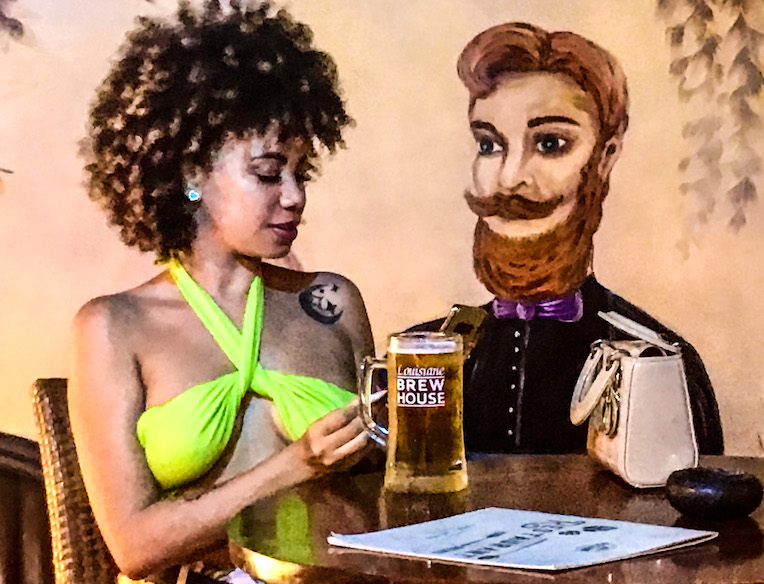
A character of indeterminate ancestry but unquestioned charm keeps company with Cuban dancer Vivian Aguilera at the Louisiane Brewpub in Nha Trang. The pub sits on the sands of one of Vietnam’s most famous beaches, where Aguilera performs in a revue. Photo by John Gottberg Anderson
To their credit, Vietnamese rarely drink alone. Men, in particular, enjoy getting together with friends to polish off those 24-can cartons in a single sitting, often accompanied by traditional snacks like dried squid and balut—fertilized duck embryos. Newcomers will be invited to join in “chugging” contests, asserting their masculinity by racing to empty a can. Although traditional lager-style rice and wheat beers are very light, often a mere 3% alcohol content, that’s still a lot of beer.
Not every Vietnamese man indulges at this level. “I don’t like this behavior,” said Nguyễn Bảo, 29. “These guys, they drink too much, and they want other people to drink together with them. But I can’t drink more than my ability.”
Môt, hai, ba, indeed.
Evolution of the Industry
Vietnamese have enjoyed fermented beverages for centuries, but it was only in the late 1800s, during the French colonial era, that modern brewing evolved. (It’s another thing for which the Vietnamese can thank the French, along with phở, bánh mì, coffee plantations and women’s fashion.)
A pair of French brewers — Victor Larue in Saigon in 1875, and Alfred Hommel in Hanoi in 1890 — were at the vanguard of the flavor revolution. At first, merely seeking to satisfy the thirst of Gallic soldiers, they soon tapped into the Vietnamese curiosity for a new beverage. With its mild and aromatic flavor compared to potent, unfiltered rice wines, the French brew was gradually embraced by middle-class Vietnamese who wanted to show off their worldliness and sophistication.
With the fall of Saigon to the communist north, 100 years after it was established, Larue’s brewery was nationalized as the Saigon Beer and Beverage Company (Sabeco). Hommel’s Hanoi brewery had been acquired by the state in 1957 after the Viet Minh army expelled the French; now it was the Hanoi Beer, Alcohol and Beverage Corporation (Habeco).
Today Sabeco dominates the national beer market with 43% of sales. Its European-style lagers include Saigon Special, a pilsner; Saigon Green, a golden lager with a malty flavor, excellent with spicy food; and the slightly stronger Saigon Red, with a hoppy aftertaste. Sabeco also makes Bia 333, a rice beer from a German recipe and a favorite of American soldiers during the Vietnam War. Once known as Bia 33, the communist government added a number to give it a post-colonial identity — but many locals still call it Ba Muoi Ba, or “thirty-three three.”
Habeco’s core brand, Bia Hà Nôi, is a crisp American-style lager and the most popular beer in the north of Vietnam. Bia Hà Nôi has an alcohol content of only 3%, but a high-end companion brew, Trúc Bach, made from imported Czech hops and French barley, is 5.1%. And then there’s Bia Hoi, a steam beer that costs as little as 5,000 Viet Nam Dong (20 cents U.S.) a glass. The company controls 15% of the domestic market.
Heineken has six Vietnam breweries and a 25% market share. Licensed in Singapore from The Netherlands in about 1900, it has been brewing its flagship beer in Ho Chi Minh City since 1991. In Vietnam, Heineken’s most popular product is Tiger Beer, an easy-drinking pale lager with 5% alcohol, still made in Singapore and exported. Bière Larue, another rice beer popular in the Vietnam War era, is made by a Heineken subsidiary in Da Nang.
Denmark’s Carlsberg Group makes eight brands for 8% of national sales. Among them is Huda, a lager manufactured in the former imperial capital of Huế and widely available throughout Vietnam’s Central Coast.
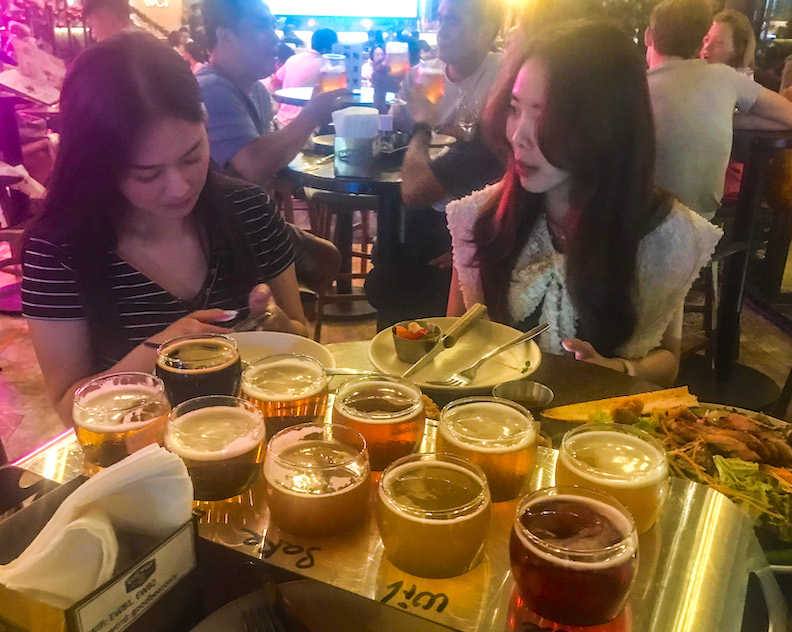
Two young women set out to conquer a King’s Flight — a sampler of 10 different beers — at the East West Brewing Company. Before them are a Far East IPA, East West Pale Ale, Pacific Pilsner, Coffee Vanilla Porter, Summer Hefeweizen, Saigon Rosé and several seasonal choices. Photo by John Gottberg Anderson
Microbrews Emerge
In Vietnam, there are 109 active breweries, most of them independently owned and operated microbreweries.
After Vietnam reopened trade to the West in the mid-1990s, a combination of foreign influence and the government’s grudging encouragement of private enterprise led to a quiet revolution in the brewing industry. At the end of the millennium, young Vietnamese studying and working abroad in Europe returned home with a new affection for European beers: Czech pilsners, Belgian sours, and German wheat beers.
Vietnam’s first micro/brewpub, Hoa Viên Brauhaus (the name means “flower garden”), started in 1995. Since then, the original four-story Hanoi beerhall has welcomed the leaders of both the Czech Republic and Slovakia on state visits and added two more brewpubs in Ho Chi Minh City. Its own barrel-aged Hoa Viên beer pays tribute to Czechia’s renowned Pilsner Urquell, which it also sells along with beer-brewed meats and other foods for beer drinkers.
The boom really began in January 2015 with the opening of the Pasteur Street Brewing Company. Founder John Reid and head brewer Alex Violette, both Americans, sought to match the style of their homeland with Southeast Asian fruits, herbs and other local flavors. Jasmine IPA and Passion Fruit Wheat Ale were immediate hits, Durian Ale, not so much. Nothing achieved the acclaim of Cyclo Imperial Chocolate Stout (with Marou chocolate, cinnamon and vanilla beans), which in 2016 became the first Vietnamese beer to win a gold medal at the prestigious World Beer Cup. Today, Pasteur Street has seven taprooms in Ho Chi Minh City and one each in Hanoi and Hoi An, along with nationwide and international distribution.
The next several years were watershed years for brewing in Vietnam. Between 2016 and 2018, such craft breweries as Heart of Darkness, East West Brewing, BiaCraft, Winking Seal and C-Brewmaster opened in Ho Chi Minh City. In Hanoi, Furbrew, Thom, Turtle Lake and iBiero established themselves as industry leaders. Even Da Nang joined the act with its 7 Bridges Brewing Company, which now has pubs in Hanoi and HCM.
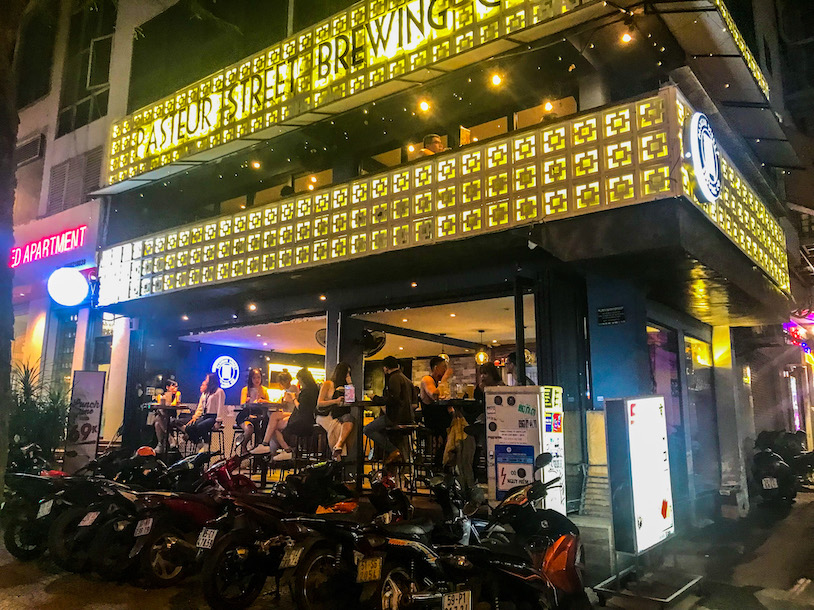
The Pasteur Street Brewing Company, which kicked off Vietnam’s craft-brewing revolution when it opened in early 2015, now has nine taprooms nationally. This one, on Le Thanh Ton in Saigon’s “Little Tokyo” neighborhood, may be the most popular. Photo by John Gottberg Anderson
‘Versatile and Interesting’
“Vietnamese already have a very strong beer culture,” affirms John Pemberton, founder and chief executive officer of the Heart of Darkness Craft Brewery. “We set out to be premium and to challenge the way people see beer. I built an authentic U.S.-style taproom with food and 20 rotating taps because I wanted to show the Vietnamese how versatile and interesting beer can be. They really get into beers now.”
Born in Australia, and raised in England, Pemberton, now 54, spent most of his 20s in Taiwan and the bulk of his 30s in New York. “That’s where I fell in love with craft beer,” he said. Returning to China in 2005, he invested eight years in the manufacturing sector in Shenzhen, “but there was no good beer. So out of frustration, I taught myself to homebrew.” He carried his hobby with him to Ho Chi Minh City in 2013 and was thrilled when, two years later, Pasteur Street Brewing opened its doors. “I was convinced my beer was better,” he recalled. “I saw an opportunity to do something I’m passionate about.”
Heart of Darkness — the name is a nod to the classic Joseph Conrad novel — started brewing in suburban Binh Duong in September 2016 and opened its District 1 pub before Christmas that year. “We brew in the American tradition of pushing the boundaries of experimentation,” Pemberton says. “We do an average of about 100 new beers a year — to date, we’ve done about 650.”
The best-sellers, Pemberton says, are Dream Alone Pale Ale, Loose River IPA and heavily hopped Kurtz’s Insane IPA. The company exports throughout Southeast Asia to Cambodia, Malaysia, Singapore, Thailand, Hong Kong and Taiwan.
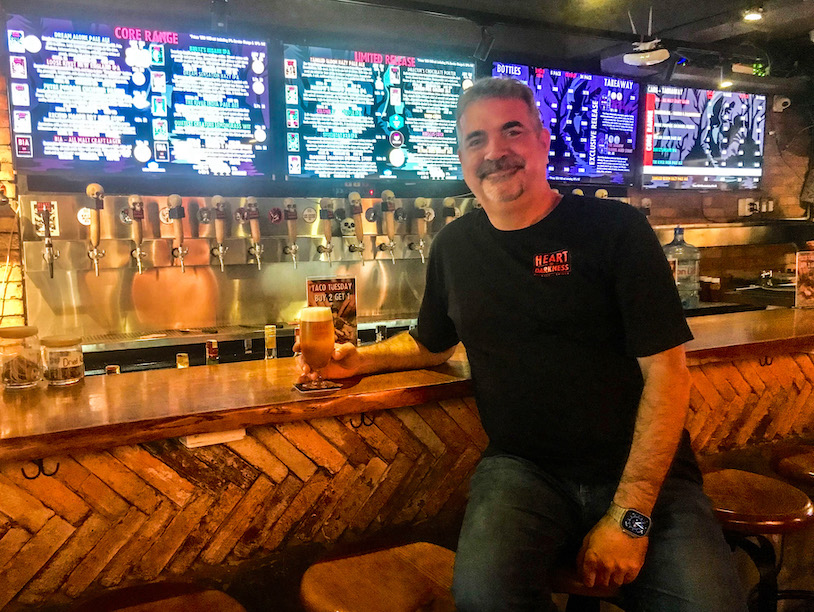
John Pemberton, founder and chief executive officer of the Heart of Darkness Craft Brewery, relaxes in his downtown Ho Chi Minh City brewpub. A self-taught brewer of British heritage, Pemberton speaks of “pushing the boundaries of experimentation” in creating about 100 new beers every year. Photo by John Gottberg Anderson
Something for Everyone
Self-proclaimed “beer geeks” enjoy compiling lists of their favorite brews. Among them, in Ho Chi Minh City: Artisan Pilsner from Belgo Belgian Craft Beer, Cool Mint Lager and Lemongrass Ale from C-Brewmaster, Far East IPA from East West, and Nam Nam Nam Cream Ale from Winking Seal.
Popular in Hanoi are spicy, herbal Bia Phở from Furbrew, Brown Chocolate from iBiero, Brown Chocolate; Dante’s Inferno from Thom Brewing, and Mango Smoothie IPA from Turtle Lake. Standouts from Da Nang’s 7 Bridges are Beach Blonde and Sunset Tangerine.
While the vast majority of microbreweries and brewpubs are in the two major cities — 35 apiece are licensed in Hanoi and Ho Chi Minh City — they can also be found in smaller cities. In the beach resort town of Nha Trang, the Louisiane Brewpub is a center of tourist activity with food, live music and six craft beers. The towns of Da Lat, Hoi An, Hue and Ninh Binh, and the resort island of Phu Quoc, also have craft breweries.
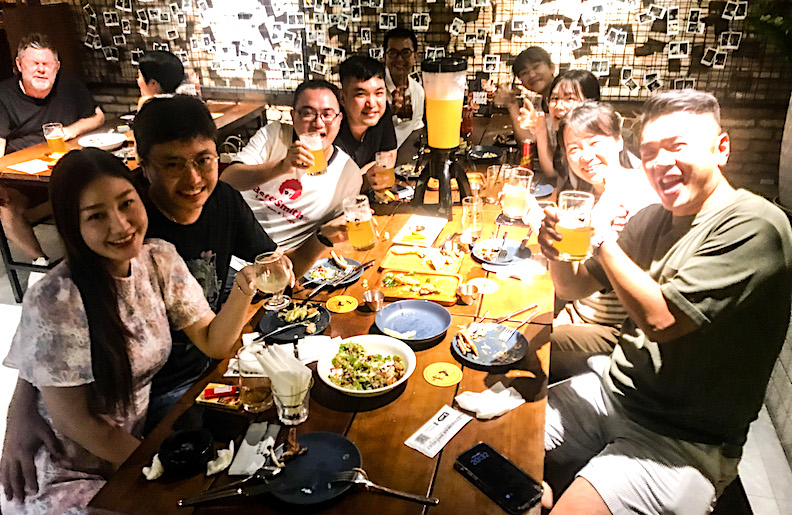
Môt, hai, ba, yo!
Where does it go from here? The brewing business shows no sign of slowing down: Traditional light beers are now exported to more than 60 countries around the world. Vietnamese will continue to enjoy their beers at family affairs and business lunches, karaoke parties and even kindergarten graduations. Môt, hai, ba, yo! ![]()
John Gottberg Anderson lives in Vietnam’s Ho Chi Minh City. Previously, he has written about Vietnam’s Tet Holiday, Cambodia’s Tonlé Sap Lake and the flowing elegance of the Áo Dài.


